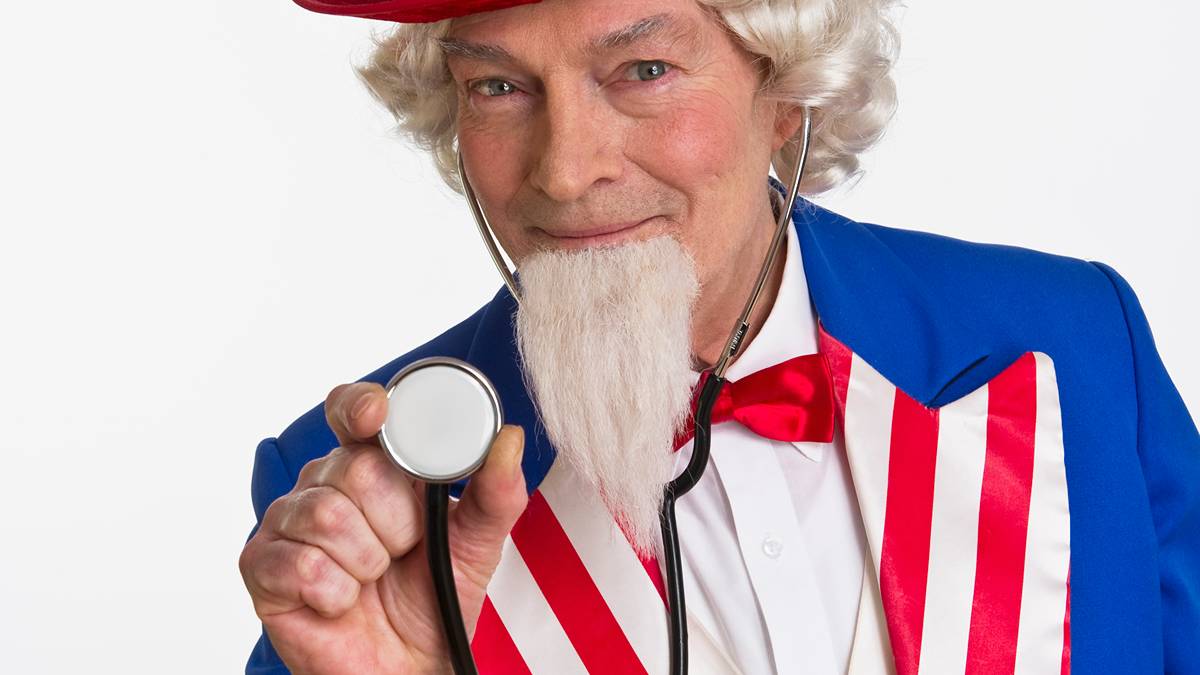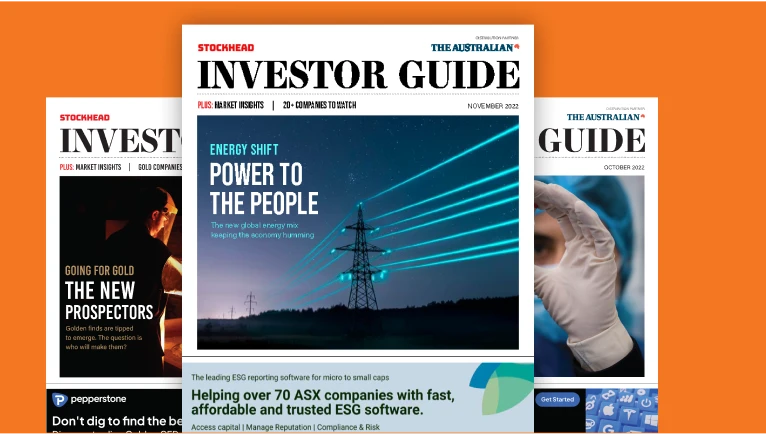Health Check: It’s all the way in the USA as ASX medtechs ramp up in Trumpland

The apparatus of US government might be shut down and the joint looks a mess, but that doesn't stop Australian medtechs from eyeing the huge potential. Pic: Getty Images
- Australian biotechs are carving out expanded territory in the US
- Truscreen edges towards cash flow break even
- CSL is extracting more blood from donors, more efficiently
Today’s crop of ASX announcements highlights the potential of the US market for Australian device and diagnostics developers.
It also shows how our companies are leaving nothing to chance to live the dream in the world’s biggest healthcare market.
Cleo Diagnostics (ASX:COV) says updated US insurance data suggests more than two million women annually could benefit from the company’s pre-surgical ovarian cancer test.
This results in a significantly larger total addressable market than first thought.
Cleo commissioned pharma research house Norstella to “reassess” this market, ahead of the company’s planned US entry this year.
The work was based on Medicaid and Medicare data, showing 3.4 million US women annually are identified with a suspected ovarian or adnexal masses (including benign ones).
“Of these, [approximately] two million women per year proceeded to further diagnostic investigation through radiological imaging and/or biomarker testing,” Cleo says.
“This cohort aligns with current pre-surgical triage practice, and clearly defines the total addressable market and immediate commercial opportunity for Cleo’s [test].”
Ovarian cancer has the highest mortality rate of all female gynaecological cancers.
US sales will ramp from here, says Orthocell
Orthocell (ASX:OCC) says investors should expect US sales momentum to build in the current quarter and grow further in the June half.
This follows the company’s US launch of its flagship nerve regeneration tool, Remplir.
In a prezzo released ahead of the company’s AGM in Perth this arvo, CEO Paul Anderson says 60 surgeries have availed of Remplir over the four months since launch.
Initial volumes have been low, as surgeons build “surgical familiarity”. But sales should ramp up from here.
Orthocell achieved $3 million of revenue in the September quarter, mainly from elsewhere.
Remplir is approved in Australia, New Zealand, Singapore, Hong Kong, Thailand and Canada.
Chairman John Van Der Wielen noted sales should grow “potentially at a faster rate as each new international geography builds”.
EBR’s Wise trial move …
EBR Systems (ASX:EBR) has enrolled the first two patients in a US post-approval study of its Wise device.
Wise is the first device in the world for left ventricular endocardial pacing.
The study will follow more than 300 patients across 50 US centres over five years, generating “both short and long-term performance metrics”.
The EBR-sponsored study will evaluate real-world results for heart failure patients using Wise, for cardiac resynchronisation therapy.
St Bernards Heart & Vascular Center in Arkansas enlisted the first two patients.
The FDA approved the Wise device in mid-April and the company has embarked on a gradual rollout.
… while Nexsen hires the clinical wise guys
Point-of-care diagnostics developer Nexsen has appointed a US adviser to expedite market entry of its two key products.
The adviser, the Washington-based clinical research organisation MRCA, will guide the way for Nexsen’s assays for Group B Streptococcus (for expectant mothers) and kidney function.
The appointment of MCRA is a “strategic accelerator for Nexsen as we advance towards US regulatory clearance and commercial entry,” says Nexsen CEO Mark Muzzin.
Nexsen plans to engage with the FDA on the GBS sensor in early 2026, in view of getting the product to market later that year.
The company targets early sales in “selected international jurisdictions” ahead of full US approval.
The kidney test targets various subsets of chronic kidney disease (CKD and acute kidney injury (AKI).
CKD affects about 700 million people globally, while AKI is present in 7% of all hospital admissions (and 30% of intensive care cases).
It’s Tru, we’re not targeting the US
Still, the US need not be the centre of the entire medtech universe.
Cervical cancer testing house Truscreen Group (ASX:TRU) says it expects to be cash-flow positive in March next year, with revenue flowing from a string of new non-US geographies.
Truscreen’s eponymous, non-invasive device aims to screen women in emerging countries who do not have access to standard lab-based ‘pap’ tests and liquid based cytology.
In a presentation, the hitherto China-focused Truscreen says revenue should flow from a public contract in Vietnam’s Ho Chi Minh City.
This program launched in April, the same month the company achieved first sales in Indonesia.
Zimbabwe is at validation stage, while Uzbekistan has moved to a pilot program.
To date, 112 hospitals have deployed 232 devices, with one million women screened so far.
In March, Truscreen struck a distribution deal with China’s Dalton Bioscience which makes DNA tests for human papilloma virus, as well as lab equipment for cervical cancer screening.
The deal entails Truscreen marketing Dalton products under the Truscreen brand.
In the year to March 2025, the Kiwi-based Truscreen recorded revenue of $1.7 million and cash outflows of NZ$2.29 million.
Given the global screening market is worth around US$8 billion, Truscreen so far has a tiny share of the pie.
According to the World Health Organisation (WHO), 600,000 women are diagnosed annually – a rate of more than one a minute.
The WHO has targeted eliminating cervical cancer by the end of the century.
What CSL said next
Having first dwelt on the Seqirus vaccines arm, CSL’s (ASX:CSL) investor showcase in Chicago has turned to the outlook for its mainstay Behring plasma arm.
In terms of market-moving revelations, again it was a case of ‘nothing to see here, move on’.
But management provided some handy morsels on revenue and cost cutting drivers, including shrinking the R&D function from 13 sites to six.
On plasma collection – the company’s, er, lifeblood – the company is getting more juice for less.
Management reports that upgraded collection systems have resulted in a 10% rise in average donor volumes, with the cost per litre falling 15% since the pandemic.
Donor fees have dropped an average 25% since the plague (unlike here, US donors are paid for their claret).
On the gnarly issues of tariffs and Most Favoured Nation drug pricing, management asserts that all “plasma products in the US are derived from US-sourced active ingredients”.
Indeed – it mainly comes from the blood of Americans.
Most of CSL’s “plasma supply chain value” is in the US.
In other words: she’ll be right cobber. Especially if the Trump-Albo bromance continues.
Still on US-focused drug makers, Neuren Pharmaceutical’s (ASX:NEU) distribution partner Acadia says it sold US$101.1 million of the Rett Syndrome treatment trofinetide in the September quarter.
That’s up 11% year on year and 5% higher than the June quarter. Acadia has guided to calendar 2025 sales of US$385-400 million, implying $63-66 million of royalties to Neuren.
Happy days? Nup – Neuren shares lost 9% this morning.
Oh no! as Polynovo facility catches alight
Wound-repair house PolyNovo (ASX:PNV) says a fire at its Port Melbourne research and development facility affected only a small section of the site and was quickly contained.
The facility was standalone and the conflagration does not affect the company’s on-site production of its Novosorb product.
The fire didn’t injure anyone. But given Novosorb is applicable to burns, any victims would have been in good hands.
Given the proximity to November 5, Guy Fawkes has been contacted for comment.
At Stockhead, we tell it as it is. While Orthocell and EBR are Stockhead advertisers, the companies did not sponsor this article.
Related Topics

UNLOCK INSIGHTS
Discover the untold stories of emerging ASX stocks.
Daily news and expert analysis, it's free to subscribe.
By proceeding, you confirm you understand that we handle personal information in accordance with our Privacy Policy.








